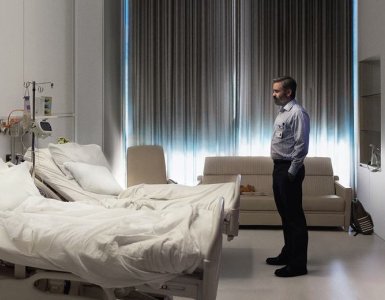Distorted compositions give way to the earthy essence of humanity in The Courtauld Gallery’s headlining exhibition.
History has not been kind to Chaïm Soutine (1893 – 1943). Unlike his contemporaries, such as Picasso or Modigliani, the chances are that most people haven’t heard of him. But if you did happen to come across an art lover familiar with Soutine, you would hear three things. You would hear about the company he kept – how he was friends with Modigliani and other émigré artists of post-WW1 Paris, united with them by poverty, ill health and a shared Jewish faith. You would also hear about his unsavory personal habits – how he and Modigliani took turns sleeping in a flea-ridden bed; how a spectacular lack of personal hygiene allowed bugs to nest in his ear undetected; or how he famously kept the carcass of a dead cow hanging in his studio until it became so rotten and rancid that the neighbours complained. And thirdly you would hear how he was a painter who worked at the borders of expressionism and abstraction, producing swirling landscapes and gruesome still lifes that prioritised form and colour over representation. But portraiture is the most challengingly representational of all genres of painting. So what then would we make of Soutine the portrait painter?
First, plaudits to the Courtauld Gallery for allowing this question to be answered so convincingly. This is an impressive exhibition. Curatorship is a tough job these days; too light a touch and the show meanders, revealing little of its subject; too intrusive a touch, and we suspect the curator’s intentions and assume there’s an ‘agenda’. This exhibition though is pitch perfect, brave in conception and marvelously well executed. The paintings are hung purposefully and supported by clear and informative texts so that we are able to (re)discover Soutine both as a painter of people and as a man.
The show starts in an ante-room where we are given a taste of Soutine’s style and introduced to his sitters – the bellboys, valets and chefs of the exhibition’s title – and continues into a larger gallery. In truth though, first impressions are not favourable. Soutine repeats the same pictorial formula over and over again. The sitters are mostly cropped half-length at the waist or else three-quarter length at the knees. All are posed square on to us. Their hands are either at their hips, elbows jutting out, or are folded passively in their laps, the cropping accentuating each pose. Initially, the faces appear formulaic too, with the same exaggerated ears, pointed chins and small dark eyes, mismatched and uneven. In combination with the plain dark colours of the backgrounds, this repetition offers us paintings with no sense of the sitter in context.
But look beyond this repetition and the next thing you notice are the colours. And when Soutine does colour, he really does colour. It starts early in the exhibition with the Butcher Boy of 1919. This painting is awash with blood; so much so, that the blood-splattered features of the sitter are hard to detect against the blood-soaked curtain of the background. Here, Soutine’s red is the primal colour of the slaughter house. And this mastery of coloration continues into the main room with the colours of his sitters’ attire. Each one is identified in terms of their role and each wears the appropriate uniform, which Soutine imbues with deep rich shades from a primary palette of red, white and black. We blink then as the bright crimson of the bellboys’ jackets assails our eyes, while the chefs’ whites swirl with the reds, blues and yellows that Soutine has found in them.
The sitters might be identified in terms of their roles, yet on closer acquaintance you notice that they are not solely defined by them. Rather, we gradually become aware of Soutine’s sympathy with his subjects. For despite the repetition of the poses and the uniforms – or perhaps because of them? – flashes of the person behind the uniform become clear. Take the Valet of 1927-8 whose attentive eyes look over your shoulder, eager to help an elderly guest struggling with their luggage. Or the sitter painted four times, starting with the Head Waiter of 1927, in which his high forehead and boxer’s nose bring to mind the hauteur of a true-born Maître d’, a man not to be messed with. Or the Room Service Waiter of 1928 whose evening dress, slicked back hair and classically handsome jawline suggest that he knows where the best band in town is playing that night.
According to Willem de Koonig, ‘Soutine distorted the pictures but not the people’. More accurately, Soutine distorted the pictures in order to reveal the essence of the people in his paintings. This is best illustrated in the Pastry Cook of Cagnes of 1922-3 who Soutine paints with real empathy and pathos. Here is a young chef, innocent and a little naïve, who seems to have just been summoned from the kitchen. Pink from the heat of the ovens, he perches anxiously on a wicker chair, still clutching the red rag he has just used to wipe his pastry board. His over-sized ears and small dark eyes give him a mouse-like quality, and we sense that while he feels obliged to pose for us, he is eager to scuttle away and prepare dessert for the paying guests.
The main caveat to the show is Soutine’s treatment of women who feature in only three out of the 21 paintings. Two of these are full length portraits, with the sitters presented in tall narrow frames. The figures seem too large in these paintings, imprisoned by the frames. These constraints magnify their servitude and unlike the male sitters, we get no sense of the dignity of their roles or of the individuals beneath the uniforms. Perhaps the range of jobs available to men in the hierarchy of Paris’s grand hotels and restaurants gave Soutine more to work with, but the women in these three paintings are generic maids and cooks, constrained in paint and perhaps individually and socially too.
But it would be an injustice to finish on a caveat, as the final two pictures on the far wall of the gallery are the most interesting and challenging in the show. Both are bellboys, resplendent in crimson workwear with gold buttons, young men accustomed to being seen and being of service. The first, the Bellboy of 1925, stands again hands on hips, elbows angular and jutting. But from the waist down, Soutine portrays his sitter with legs splayed wide, almost straining for balance. One knee is slightly bent, the other leg stretches straight out to the side as if this young man is limbering up for a foot race. And he clearly is a man. His groin thrusts towards us just below our eye line, his sex obvious and bulging. His fleshy hands provocatively narrow his waist, drawing our attention down the painting to this triangle of hands and groin. The red of his trousers and hat is reflected in the red of his pursed lips but beyond that, his face offers no clues as to what is going on between us and him.
The second bellboy, Page Boy at Maxim’s of 1927, is even more unsettling. A rare full-length portrait, this bellboy’s right hand is stretched out towards us, palm upwards. This hand is empty and we can see coins visible in his other fist. Perhaps he is asking for a tip, but for what? Curiously characterless, his eyes don’t express expectation or gratitude; instead they look like the cold, black eye sockets of a corpse. These two then are markedly different to the rural chefs and pastry cooks of the rest of the show – more venal, more urban, more knowing, and an intriguing end to a fine exhibition.
By now, it is also clear where Soutine’s sympathies lie. Perhaps as an émigré artist, an outsider himself, he chose not to paint the guests of the grand hotels. Instead he painted those that served them with respect, affection and insight, endowing his sitters with a dignity and an individuality that transcends their uniforms and station in life. His sitters may be servants but they are not servile.
So go and make the acquaintance of these splendid fellows. Spend some time in their company and you’ll get to know them – and Soutine – well.
Soutine’s Portraits: Cooks, Waiters and Bellboys is on at The Courtauld Gallery, Somerset House, until 21 January.








Add comment